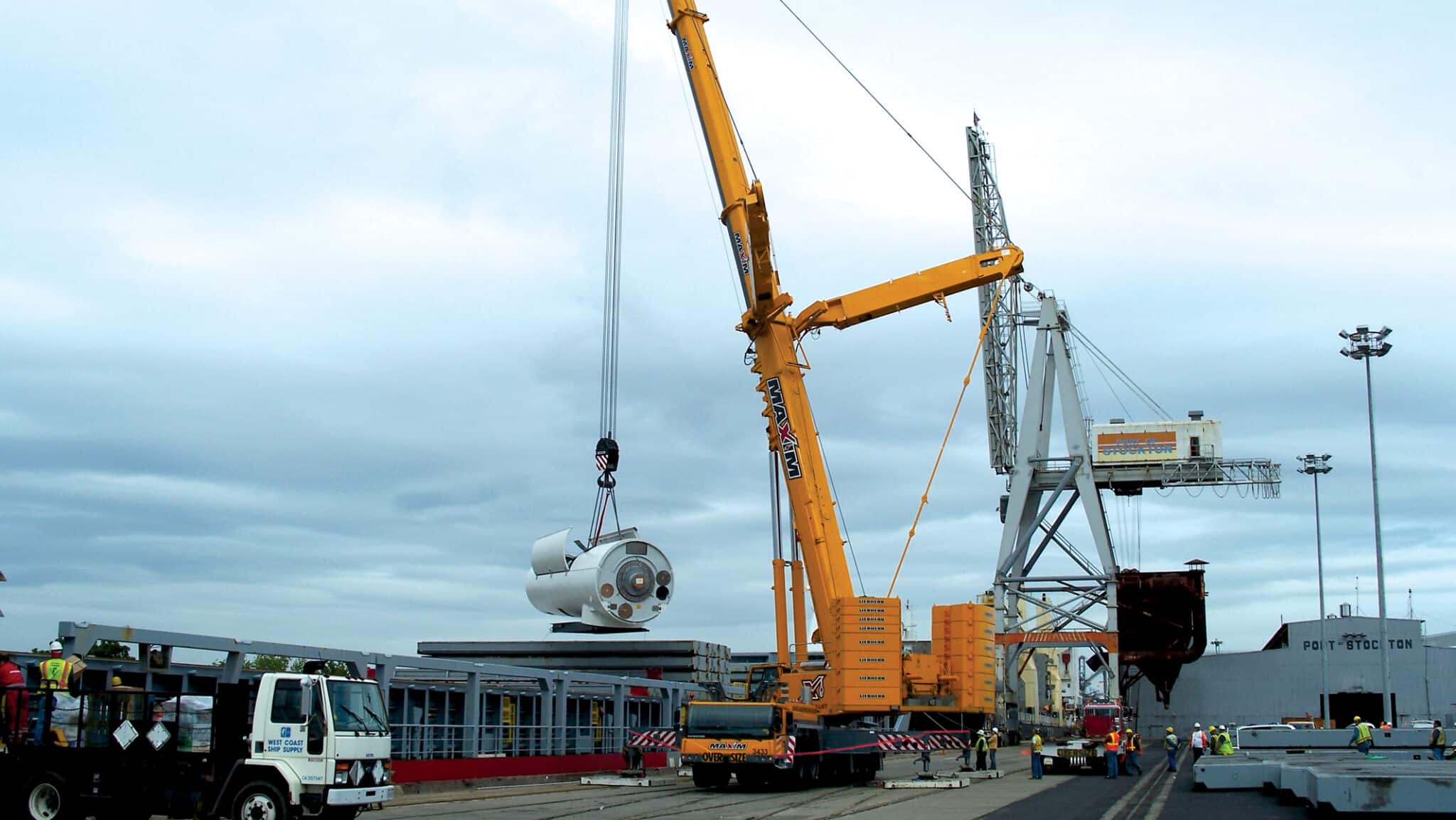Navigating through the complexities of a construction project becomes considerably smoother when you possess the right machinery. Among the diverse lineup of construction equipment, all-terrain cranes stand out due to their superior adaptability and flexibility.
These multipurpose machines shine in demanding environments, providing a seamless performance regardless of weather or surface conditions. This blog unravels the unique capabilities of all-terrain cranes, acquainting you with their distinct advantages, and helping you understand why they are a chosen heavyweight in the industry.
Understanding All-Terrain Cranes
In the world of construction, adapting to dynamic circumstances is critical. The machinery used must be versatile to perform optimally under varying conditions. All-terrain cranes, designed with this in mind, demonstrate superior adaptability, performing seamlessly across different terrains and weather conditions. Their heightened mobility and speed set them apart from other crane types.
All-terrain cranes are robust powerhouses, bringing together the strength of hydraulic truck cranes and the unrivaled mobility of the rough terrain crane. Opting for an all-terrain crane over these alternatives can mean more efficient work. Key benefits of all-terrain cranes include:
- Comprehensive all-wheel steering suspension system
- Navigational ability across sandy and gravel-filled settings
- Effortless operation on asphalt roads and highways
- Self-transport ability between job sites
- Increased lifting power
- Speeds of up to 55 miles per hour
- Compact design for easy maneuvering
- Built-in boom feature
- Adjustable undercarriage enhancing mobility
- Flexible configurations with various attachments
- Exceptional durability for extended lifespan
- Enhanced comfort and convenience
- Improved visibility for operators
Picture the awe-inspiring skyscrapers that make up a city skyline – their existence is down to construction cranes. Without them, our world would be much less vertical. Envisioning this underscores why cranes are often termed the backbone of the construction industry.
Construction cranes are a familiar fixture in modern urban environments, playing an integral role in shaping our built landscapes. Have you wondered how they lift and maneuver such immense weights? If so, you’re in the right place. Continue reading to gain insights into these phenomenal machines.
Understanding The Distinctions: All-Terrain vs. Rough Terrain Cranes
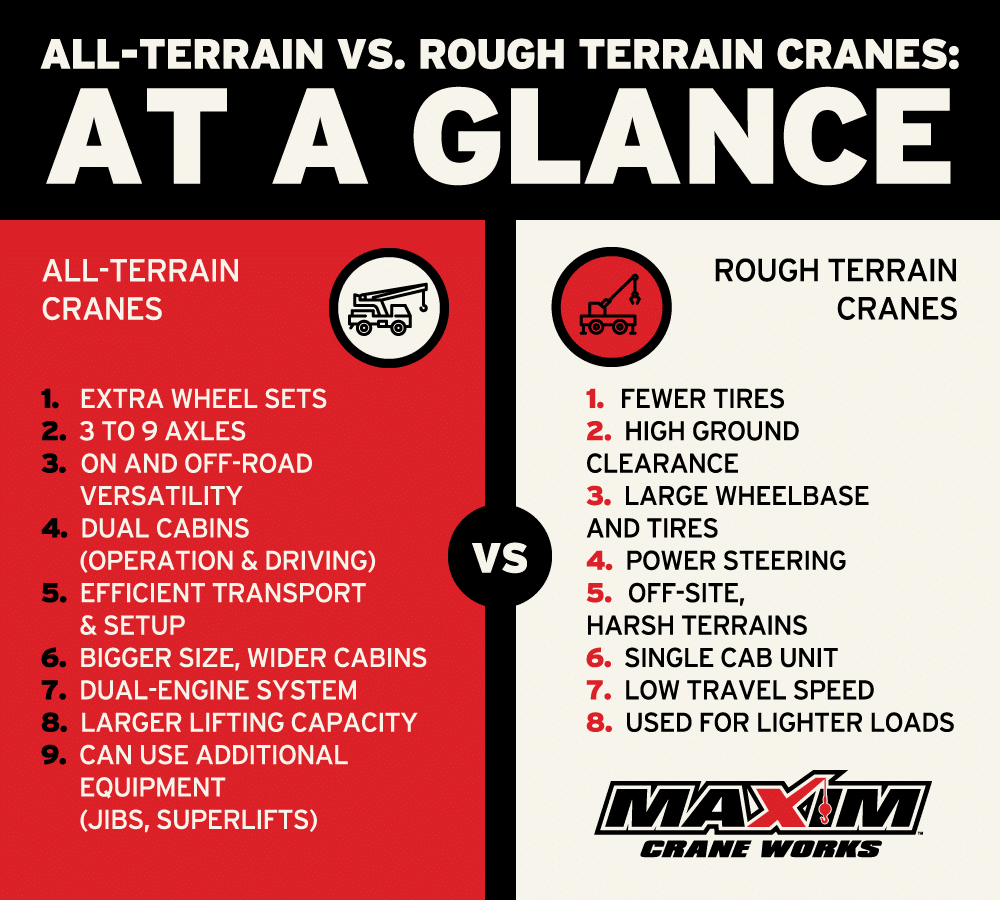
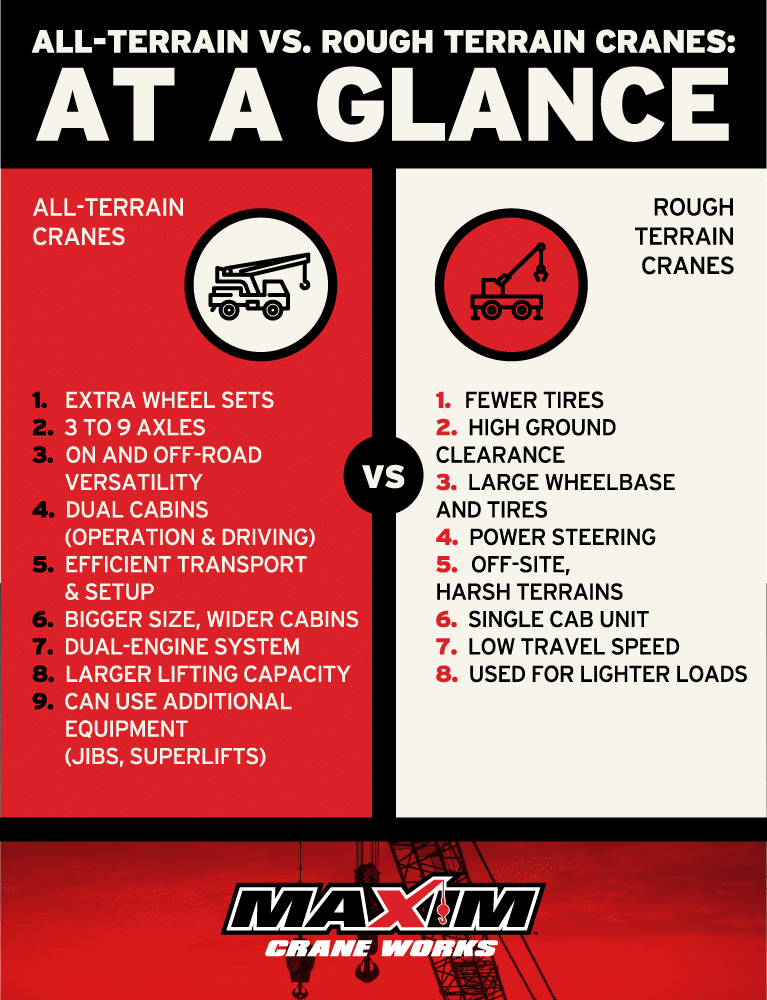
Despite bearing some resemblances, all-terrain and rough terrain cranes are not identical and serve different purposes.
Rough terrain cranes are designed with a limited number of tires and high ground clearance, which enable them to navigate through harsh, unimproved terrains without the need for specialized attachments.
They also boast a broad wheelbase and large tires for enhanced stability, coupled with integrated power steering. These cranes are specifically built for off-site tasks due to their excellent performance in unstable conditions. However, they’re unfit for traditional roads as their low travel speed makes them inefficient for such use. Furthermore, they feature a single cab for crane operation and driving, simplifying their operation.
In contrast, the all-terrain cranes are more versatile. They typically feature additional wheel sets for improved site mobility, utilizing between three and nine axles create an all-wheel drive and steer. These cranes are capable of smooth operation on a variety of grounds, including highways and regular roads. They are specifically designed to function in on-road and off-road conditions, integrating two separate cabins–one for crane operation and another for driving. This design enables efficient transport between job sites along roads and highways, leading to minimal setup time.
Size and load capacity-wise, all-terrain cranes supersede rough terrain cranes. They come with wider cabins induced for increased operator comfort throughout operation and most feature a dual-engine system that increases weight and thereby enhances stability during lifting operations. Furthermore, all-terrain cranes have a larger lifting capacity, whereas rough terrain cranes, though rugged, are usually employed for lighter loads. To increase their reach and load-lifting capabilities, all-terrain cranes can be affixed with additional equipment, such as luffer jibs and superlifts.
The Versatility of All-Terrain Cranes: What Can They Do?
The adaptable nature of all-terrain cranes sets them apart as highly flexible lifting machines. Their distinctive ability to perform on both on-road and off-road surfaces vastly expands their utility in the construction field. These versatile lifters are particularly advantageous for job sites that lack road accessibility and can also be employed effectively within urban construction sites, especially where job locations are closely situated.
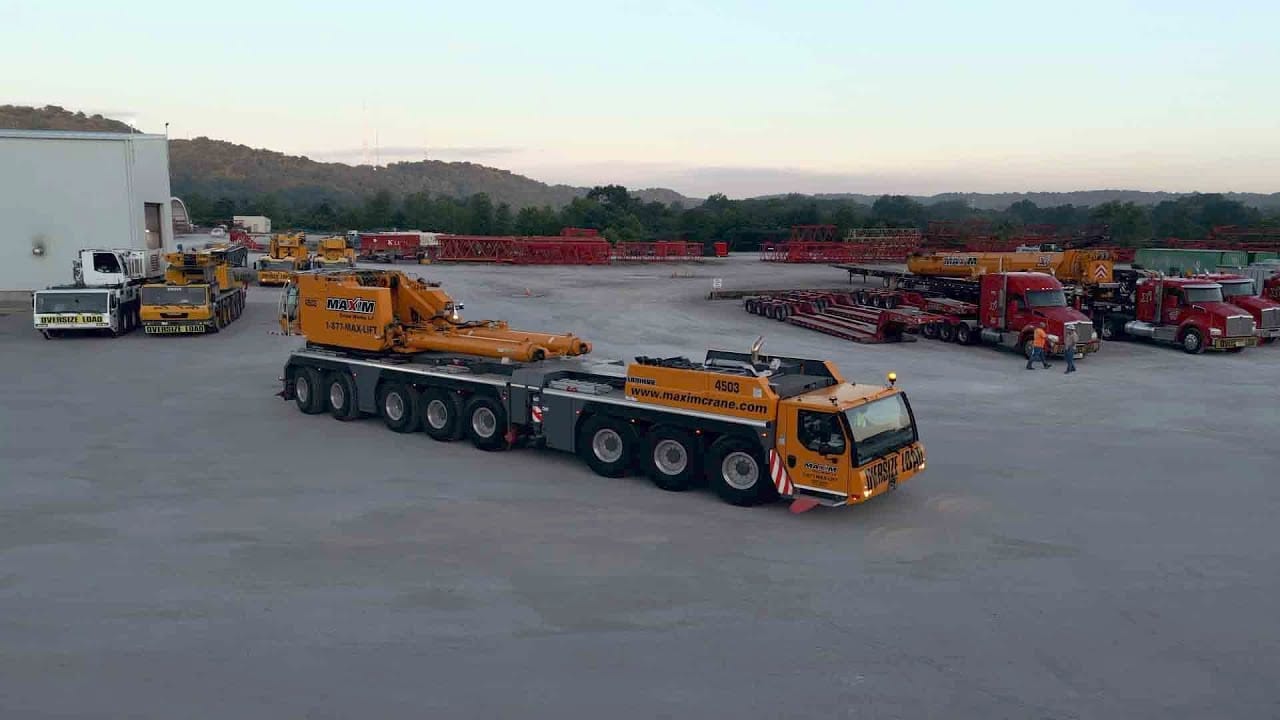
All-terrain cranes are a one-size-fits-all solution for many work environments, excelling in both building-related tasks as well as managing large volume operations. They are utilized broadly across numerous tasks such as:
- Wind turbine assembly
- Pipeline installation
- Precast concrete building section lifts
- Steel erecting
- Lifting construction materials like bricks
- Cell phone tower construction or upgrades
- HVAC work
- Building Tower/Crawler cranes
One of the primary advantages of all-terrain cranes is their robust mobility and stability system. Equipped with sophisticated suspension and all-wheel steering systems, all-terrain cranes can maneuver through challenging terrains with remarkable ease. This exceptional mobility not only allows them to navigate through rough and uneven landscapes but also facilitates precise positioning and setup on site, which is essential for optimal lifting operations.
This capability ensures that all-terrain cranes can be swiftly and efficiently repositioned as needed, maximizing productivity on the job site. Such features underline the importance of these cranes in projects requiring high levels of flexibility and mobility.
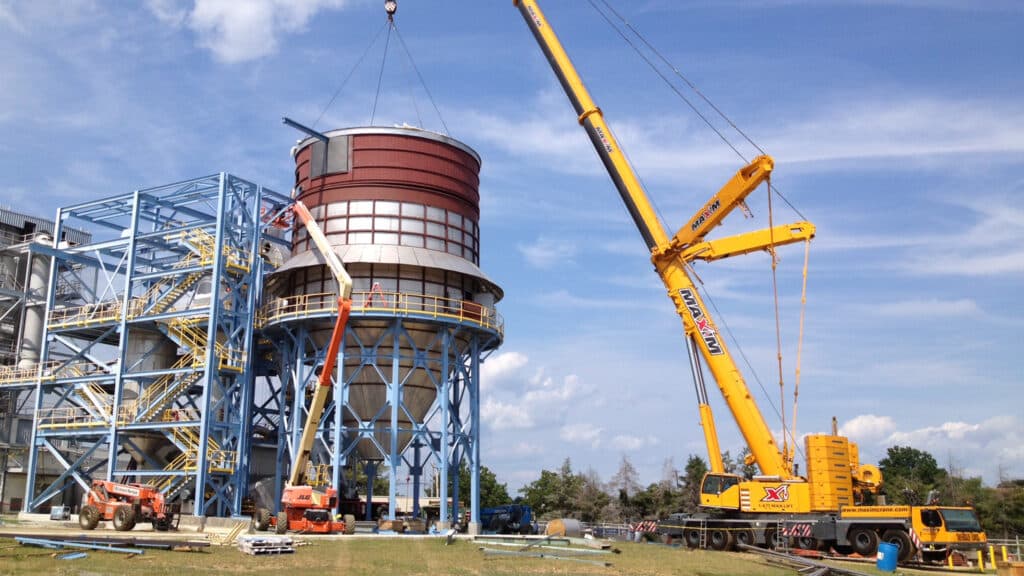
How Have All-Terrain Cranes Changed Over the Years?
The earliest cranes used by our ancestors were manually operated systems that utilized levers and ropes to lift heavy loads. These manual construction cranes facilitated movement across various types of terrain, enabling the construction of the architectural marvels noted in history books. Nonetheless, these early cranes required significant human effort and time, making the construction of grand projects like temples and stadiums a lengthy process.
Fast forward to the first steam-powered cranes that emerged in the 19th century. Another century later, steam-powered cranes were replaced by hydraulic, electric, and internal combustion alternatives. All these construction devices were massive. They were heavy and didn’t allow for mobility within the worksite. They did the job but they were far from becoming the versatile machines we know today.
Mobile cranes made their first appearance during the post-war period. Before mobile cranes reached the mainstream, engineers would use them to lift heavy military equipment and debris. The newfound mobility of cranes made demolition and clearance efforts much easier in this period.
During the post-war building boom, mobile cranes were further developed. They provided an excellent way to simplify tasks and make the construction process faster. Mobile cranes were used to develop residential and commercial buildings, reducing construction times and optimizing costs.
The benefits of mobile cranes didn’t stop there. These lifting devices were later introduced to other industries as a more affordable option to manage high volumes of goods and materials. The use of cranes stopped being exclusive to the construction industry and became widespread in shipping, transportation, and warehousing.
As time went by, cranes became more cost-efficient and convenient. Newer and more powerful generations of mobile cranes started to appear. They turned into specialized multitasking vehicles. This is when all-terrain models first saw light and became indispensable in all heavy-lifting scenarios.
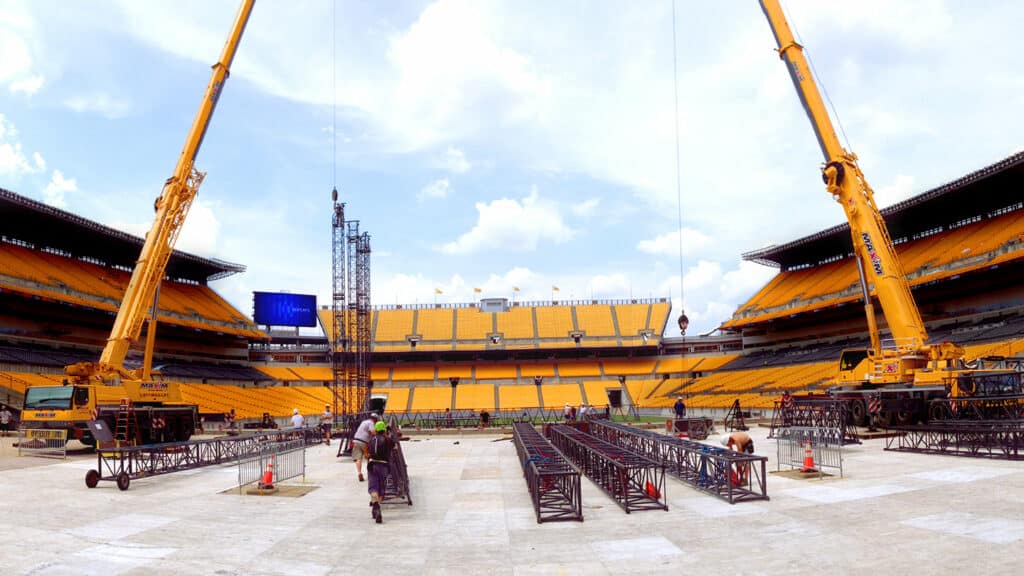
Harnessing the Power of All-Terrain Cranes for Superior Job Site Performance
When it comes to harnessing power, flexibility, and resilience on your work site, all-terrain cranes rise as a quintessential choice. These engineering marvels are not only notorious for their exemplary dexterity but also create a swift and seamless material handling experience, giving them a distinct edge over conventional cranes. Designed in an array of models, they can be tailored to meet the distinctive needs of varied job sites.
Surpassing the performance of hydraulic and rough terrain cranes in virtually every aspect, the benefits of incorporating all-terrain cranes into your job site are manifold:
- Capability for flawless operation, both on-site and off-site
- Resilience in diverse weather conditions, ensuring uninterrupted workflow
- Unparalleled maneuverability due to their robust build
- Compliance with public roads, contributing to their ease of transport
Integrating all-terrain cranes into your job site can offer a wealth of enhancements to your operations. Renowned for their ability to move at high speeds on varied surfaces, these cranes also feature adjustable booms for added work efficiency.
Diverse Load Lifting Capacities
All-terrain cranes exhibit immense flexibility in their load-lifting capacities. Whether you’re handling smaller materials or executing large-scale operations, these cranes can lift from a few tons up to several hundred tons, providing a comprehensive solution to your site-specific needs.
Long-lasting Durability
Designed to endure heavy-duty operations, all-terrain cranes offer high durability. Their robust build reduces the need for frequent maintenance, ensuring longevity and reduced operational costs.
Incorporating all-terrain cranes into your job site can significantly improve project outcomes. These cranes embody the marriage of efficiency, flexibility, and robustness, making them an investment that pays off in terms of productivity and cost-effectiveness.
Ease of Transport
Additionally, the ease of transport of these cranes is second to none. Their integrated flatbed or lorry design makes them simple to move from site to site, eliminating the need for additional transport equipment.
In conclusion, all-terrain cranes are the toolkit’s superior solution, designed with efficiency, versatility, and durability in mind. Their adoption into your job site can dramatically increase productivity and streamline operations while ensuring cost-effectiveness.
Understanding the Load Capacity of All-Terrain Cranes
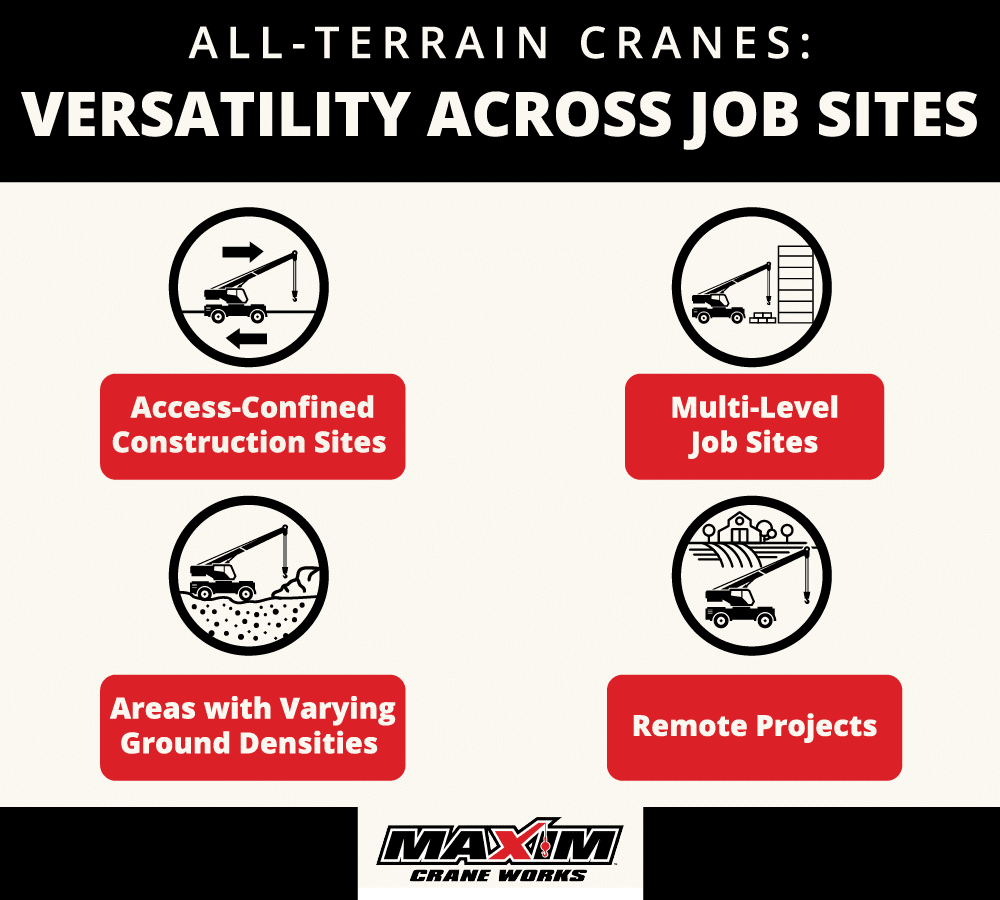
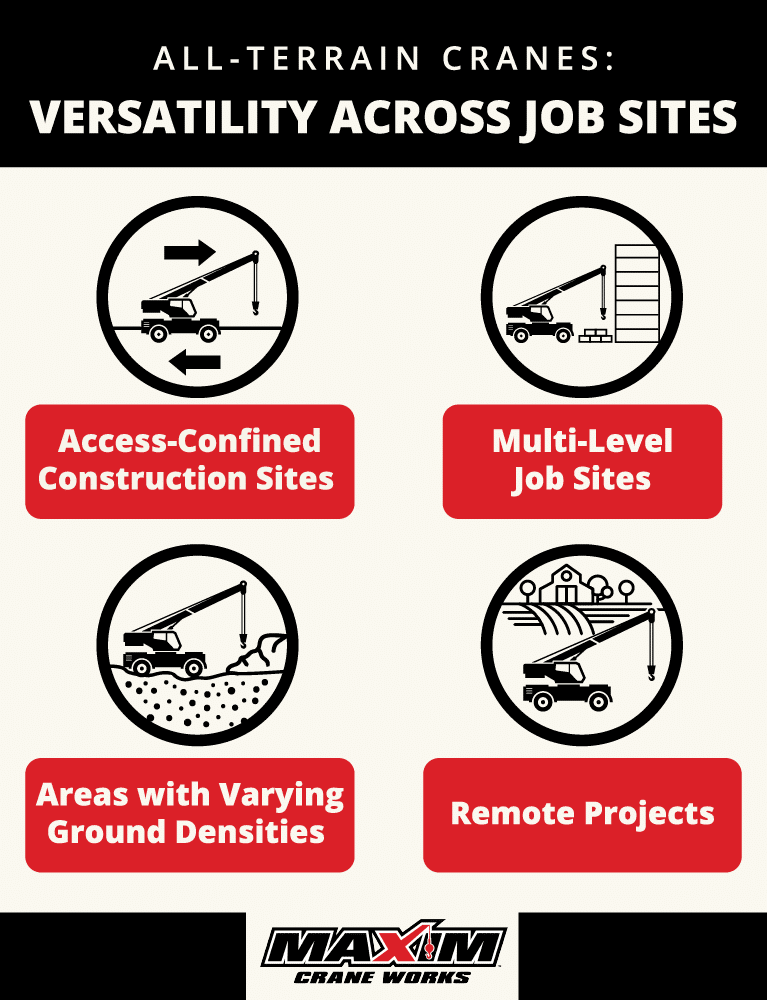
All-terrain cranes stand as essential giants in the realm of construction, offering unrivaled mobility and adaptability, and thus, being a staple for myriad projects. Often housing two powerful engines within their robust frames, these versatile machines deliver a potent punch of performance, often serving as a go-to option across diverse construction landscapes.
So, wondering when these all-terrain powerhouses can up your game? Here’s when you might need an all-terrain crane:
Access-Confined Construction Sites
All-terrain cranes can effortlessly navigate environments lacking streamlined road access, thanks to their specialized structure that grants superior mobility. This capability makes them ideal for urban construction projects where space is at a premium.
For example, in densely populated areas, such as city centers, where building high-rise structures or conducting major renovations requires heavy lifting in confined spaces, all-terrain cranes shine. In the real estate development industry, involving high-rise buildings and skyscrapers, these cranes are commonly used for the construction and maintenance of office towers and residential complexes. Their ability to maneuver through tight city streets and alleys makes them indispensable.
Multi-Level Job Site
These durable cranes can tackle variations in workground elevation with finesse, proving instrumental in multi-level sites with different floor heights. They are particularly beneficial in complex infrastructure projects that involve constructing bridges, overpasses, or layered utilities.
Civil engineering projects, such as the construction of major highways, railways, and viaducts, often require precision lifting across multiple levels of terrain. All-terrain cranes provide the necessary efficiency and safety, ensuring materials and components are lifted to various heights reliably.
Areas with Varying Ground Densities
By being adjustable to the soil’s firmness or softness, all-terrain cranes can securely operate in regions having different ground densities. This makes them invaluable in industries like mining and road construction.
For example, in mining operations, extraction sites might have unstable or varied ground compositions that require adaptable machinery for the safe movement of heavy equipment and materials. In mineral extraction and exploration projects, particularly in regions with soft or uneven soil, such as oil sands or gravel pits, the adaptability of all-terrain cranes ensures stable footing and safe operation.
Remote Projects
Equipped with impressive reach and rugged built, all-terrain cranes are an excellent resource for remote or inaccessible construction sites. Their versatility is crucial in the establishment of renewable energy resources and infrastructure development in hard-to-reach areas.
Renewable energy installations, like setting up wind turbines or solar panels, often take place in secluded or rugged terrain far from populated areas. In renewable energy projects, including wind farms and solar energy plants located in remote areas, the capability of all-terrain cranes to handle tough terrains and long distances enhances project efficiency and safety.
In essence, all-terrain cranes are a vital cog in the machinery of contemporary construction, providing a dynamic lifting solution to a multitude of project-types.
The Final Take: Entrusting Your Heavy Lifting Tasks to All-Terrain Cranes and Maxim Crane
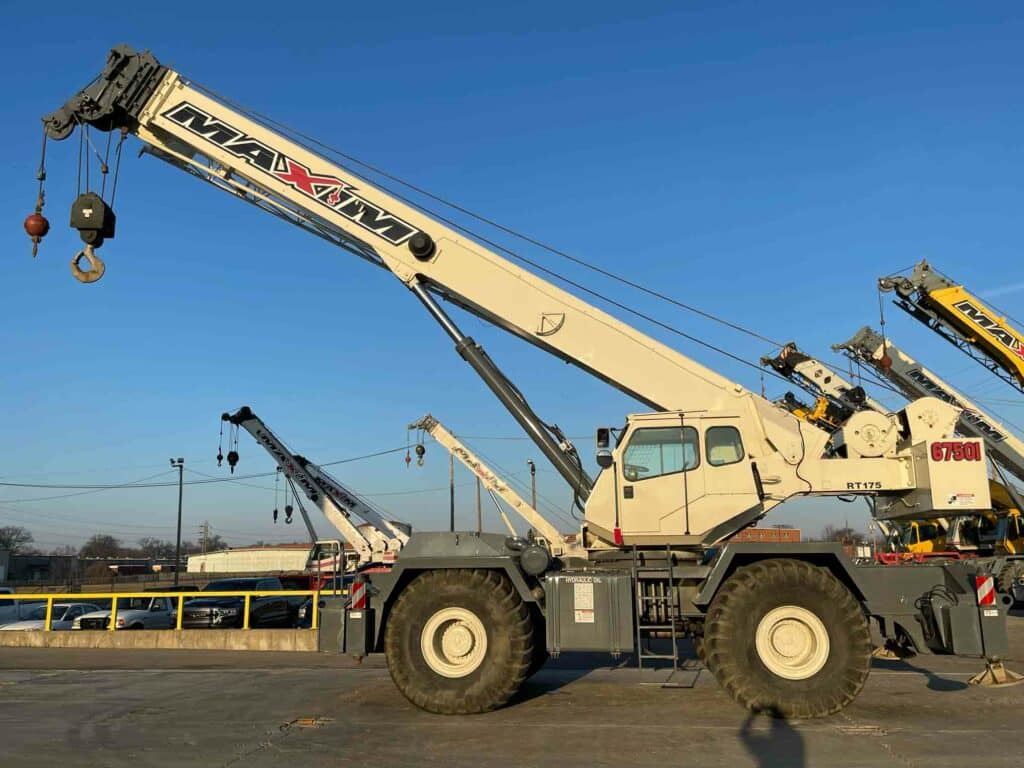
The versatility and adaptability that all-terrain cranes extend helps to reassure success in handling complex projects, even in the trickiest terrains. Combining the best functionalities of hydraulic and rough terrain cranes, all-terrain cranes are undeniably a more streamlined, efficient, and cost-effective solution for facing the challenges of diverse terrains and remote worksites.
If you’re undecided about the right crane to meet your unique project requirements, we invite you to explore the all-terrain cranes offered by Maxim Crane, a leading crane rental company. With one of the world’s most diverse and comprehensive fleets of cranes backed by top-notch management services, Maxim Crane is committed to providing innovative lifting solutions tailored to your needs.


